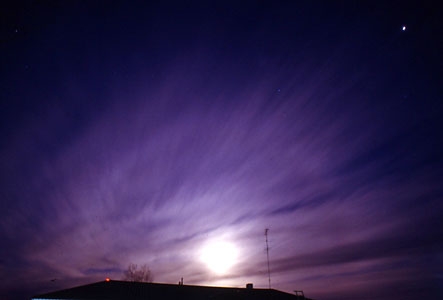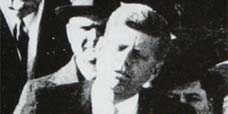
Craig D. Wandke's lunar passion began during the afternoon of July 20, 1969, when, as a Peace Corps volunteer, he looked up at the crescent moon in the sultry Honduran sky, heard Neil Armstrong's voice crackle over his shortwave radio, and was completely riveted by his small step onto the Sea of Tranquillity
At night, I'm drawn to the moon
By Craig D. Wandke
Caption: Moonlight passing through tiny ice crystals in high clouds can refract to form a rainbow ring around the moon. The phenomenon is called a halo or glory. Given the right conditions, halos form around the sun, too.
My lunar passion began during the afternoon of July 20, 1969, when, as a Peace Corps volunteer, I looked up at the crescent moon in the sultry Honduran sky, heard Neil Armstrong's voice crackle over my shortwave radio, and was completely riveted by his small step onto the Sea of Tranquillity.
Upon my return to the States, I rushed out to purchase a dime-store telescope on a rickety tripod and began a love affair with the moon that continues to excite and inspire me. Since those early years I have made nearly 2,000 drawings of Earth's nearest neighbor, meticulously rendered at the eyepieces of the various telescopes that I have owned and cherished over my ensuing decades of lunar exploration.
Shunning the cameras, computers, CCDs, and other high-tech automated gizmos of many of my fellow amateur astronomers, I continue to draw - in the tradition of Galileo and other early moonwatchers - black-and-white pencil and India ink images of the moon. Drawings, which require the concentrated interplay of hand and eye, provide me an intimate relationship with the moon that would be lost with more advanced technologies.
My sole concession to modernity is the motor drive on my five-inch refracting telescope. The motor counteracts the Earth's rotation and keeps the moon centered in my eyepiece. Because it is not necessary to have dark-adapted vision when looking at the moon, I am able to make my telescope drawings on a clipboard with the comfort of a standard white-light lamp by my side.
During my public lectures about the moon to civic groups and schools, my audience frequently asks, "But isn't the moon a changeless world? What's there to draw?" Clearly, I am not drawing real, intrinsic changes. Rather, I record the endless dance of light across the moon's geological formations. This dance occurs each night, as it has for billions of years. Light's inexorable movement over deep valleys, imposing mountain chains, somber craters, and venerable lava flows presents a never-ending visual feast to observers.
The discerning eye at the telescope can detect the small changes that take place as the terminator - the line visible from Earth that defines lunar day and night - inches westward across the moon's surface at the rate of 12.5 degrees each day. The changes are detectable on the lunar surface in as little as 15 minutes. They parallel the larger monthly changes with which we are all familiar, as the moon cycles from new, to first quarter, to full, to last quarter - and back again to new.
It is this movement of light that results in both subtle and dazzling changes on the lunar surface, and these changes are a source of such fascination for me: An 18,000-foot high peak begins to appear at lunar dawn; a crater 80 miles in diameter disappears into the two-week void of lunar night;
a mountain range 450 miles long casts compelling shadows at lunar sunrise on the barren plain far below; an odd, unidentified feature becomes prominent at full moon, sending me to my lunar atlases before I identify it as a familiar peak, cleverly disguised by the sun's harsh light falling on it from directly overhead.
As I draw what I see at the eyepiece, it is an additional thrill to think about the fact that, during the pervious eight minutes, the photons of light I perceive traveled all the way from the sun to the moon, then were reflected by the moon into my telescope. The light that carries the moon's image to me was quite literally on the moon's surface just seconds ago.
While at the eyepiece I often reflect on the science, art, and metaphysics of the observing experience.
During my solitary nightly visits with the moon, I have had ample time to ponder the mighty forces that created the grand formations on the lunar surface, the constancy of its phases as an example of the order and predictability of the universe, the nature of time as reflected in the vast expanse of the moon's 4 billion-year-old existence, humanity's astounding skill at having been able to land on our satellite, and even the human ability to wonder and be inspired through mind and eye.
Tonight - weather permitting - I will return to my telescope with clipboard and drawing instruments, as I have done for more than three decades, confident that new delights await me and that I will again be captivated by the mystery and beauty of my old friend in the sky.









